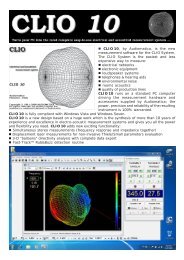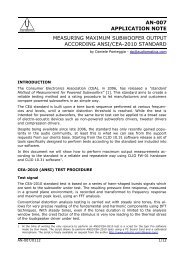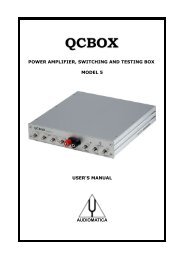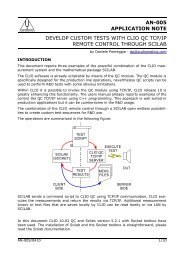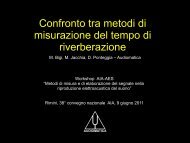CLIOwin 7 PCI User's Manual - Audiomatica
CLIOwin 7 PCI User's Manual - Audiomatica
CLIOwin 7 PCI User's Manual - Audiomatica
Create successful ePaper yourself
Turn your PDF publications into a flip-book with our unique Google optimized e-Paper software.
12.4 MAKING A CUMULATIVE SPECTRAL DECAY<br />
A cumulative spectral decay starts loading an impulse response from disk. Suppose we<br />
have taken an anechoic response of a medium sized two ways loudspeaker; the impulse<br />
response is shown in Fig.12.3.<br />
Let's first select a reflection free part of it. By selecting the start and stop window points<br />
we obtain the first two information parameters required for the waterfall facility: zero<br />
time will be referenced to the start of the start window, while the Z axis will provide the<br />
measurement range between the stop and start window points (unless a Time Shift is<br />
chosen).<br />
Figure 12.3<br />
Going inside the Waterfall Settings dialog we decide to view our measurement between<br />
150 and 20000Hz, then apply 1/12 octave smoothing. We are now ready for a<br />
waterfall!<br />
Figure 12.4<br />
The Go button is enabled. Press it, you should obtain a waterfall like the one in the left<br />
part Fig. 12.5. Press now the Color Scale button followed by the Interpolate Colors<br />
buttons, now you should have the color map shown in the right part of Fig. 12.5. The<br />
two representations are not exclusive, they mutually complement each other; you will<br />
gain experience understanding all the subtle details of a waterfall processing and how<br />
they are represented either in the 3D or in the color map. For example the color map<br />
represents better the frequency of decaying modes as they result as straight color<br />
patterns parallel to the time axis; the 3D waterfall is more familiar when you look at<br />
zero time frequency plot and try to visualize how it modifies during decay.<br />
Chapter 12 - Waterfall and Directivity 147








